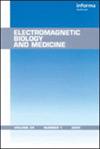Wi-Fi 2.4 GHz射频辐射对脑内部分miRNA和脂肪酸组成的影响
IF 1.6
4区 生物学
Q3 BIOLOGY
引用次数: 5
摘要
摘要:本研究旨在探讨手机、电脑等无线设备持续使用2.4 GHz Wi-Fi接入网络对脑细胞microRNA、细胞膜和储存脂肪酸组成的影响。将16只Wistar白化大鼠平均分为假组和暴露组。实验组大鼠(n = 8)每天24小时暴露于Wi-Fi发生器发出的2.4 GHz RFR,持续一年。对照组(n = 8)与实验组保持相同的条件,但关闭Wi-Fi发生器。实验结束时,处死大鼠,取脑,分析miRNA表达及脑细胞膜和储存脂肪酸。我们在本研究中分析了10种不同的miRNA表达情况和19种脂肪酸模式。我们观察到,长期和过度暴露于2.4 GHz Wi-Fi辐射会增加大脑中的rno-miR-181a-5p、磷脂酰丝氨酸(PS)和三酰甘油(TAG)。综上所述,2.4 GHz Wi-Fi暴露有可能改变rna - mir -181a-5p的表达和一些膜脂(如磷脂(PL)、磷脂酰丝氨酸(PS)和三酰甘油(TAG))的脂肪酸百分比,这些膜脂是大脑中的储存脂肪。然而,不受控制地使用RFRs,其使用和多样性日益达到令人难以置信的水平,并且在未来还会增加,可能会为我们今天无法与之联系的许多疾病铺平道路。本文章由计算机程序翻译,如有差异,请以英文原文为准。
Role of 2.4 GHz radiofrequency radiation emitted from Wi-Fi on some miRNA and faty acids composition in brain
ABSTRACT The purpose of this study is to investigate the effects of 2.4 GHz Wi-Fi exposure, which is continuously used in the internet connection by mobile phones, computers and other wireless equipment, on microRNA and membrane and depot fatty acid composition of brain cells. Sixteen Wistar Albino rats were divided equally into two groups such as sham and exposure. The rats in the experimental group (n = 8) were exposed to 2.4 GHz RFR emitted from a Wi-Fi generator for 24 h/day for one year. The animals in the control group (n = 8) were kept under the same conditions as the experimental group, but the Wi-Fi generator was turned off. At the end of the study, rats were sacrificed and brains were removed to analyze miRNA expression and membrane and depot fatty acids of brain cells. We analyzed the situation of ten different miRNA expressions and nineteen fatty acid patterns in this study. We observed that long-term and excessive exposure of 2.4 GHz Wi-Fi radiation increased rno-miR-181a-5p, phosphatidylserine (PS) and triacylglycerol (TAG) in the brain. In conclusion, 2.4 GHz Wi-Fi exposure has the potential to alter rno-miR-181a-5p expression and the fatty acid percentage of some membrane lipids such as phospholipid (PL), phosphatidylserine (PS) and triacylglycerol (TAG), which are depot fats in the brain. However, the uncontrolled use of RFRs, whose use and diversity have reached incredible levels with each passing day and which are increasing in the future, may be paving the way for many diseases that we cannot connect with today.
求助全文
通过发布文献求助,成功后即可免费获取论文全文。
去求助
来源期刊
CiteScore
3.60
自引率
11.80%
发文量
33
审稿时长
>12 weeks
期刊介绍:
Aims & Scope: Electromagnetic Biology and Medicine, publishes peer-reviewed research articles on the biological effects and medical applications of non-ionizing electromagnetic fields (from extremely-low frequency to radiofrequency). Topic examples include in vitro and in vivo studies, epidemiological investigation, mechanism and mode of interaction between non-ionizing electromagnetic fields and biological systems. In addition to publishing original articles, the journal also publishes meeting summaries and reports, and reviews on selected topics.

 求助内容:
求助内容: 应助结果提醒方式:
应助结果提醒方式:


